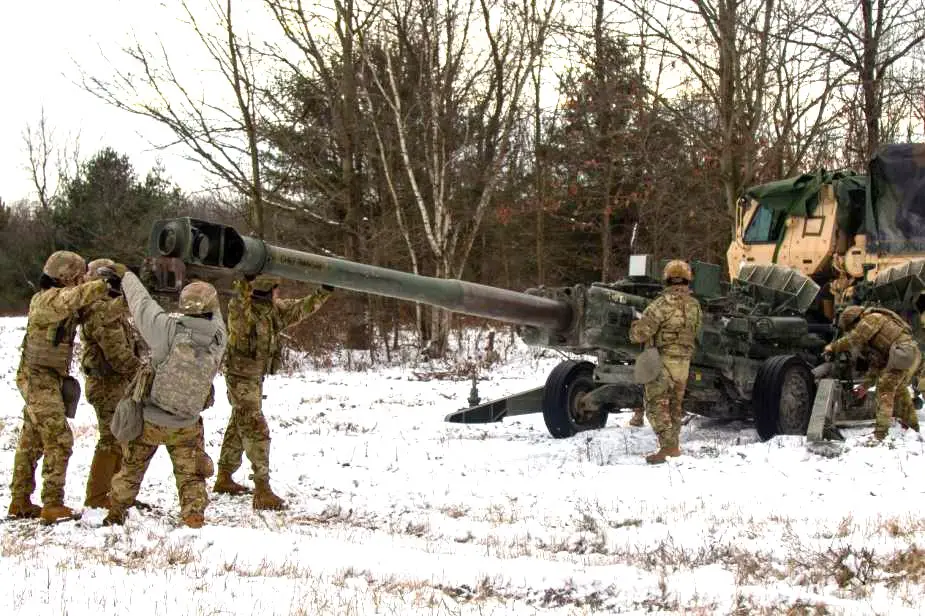Breaking news
US Alpine artillery troops showcase tactical excellence.
U.S. soldiers with C Battery, 3rd Battalion, 6th Field Artillery Regiment, 1st Brigade Combat Team, 10th Mountain Division, rehearsed and conducted Artillery Table XV from Nov. 29 to Dec. 3 on Fort Drum to qualify their artillery crews. Pfc. Elijah Campbell reports.
Follow Army Recognition on Google News at this link

Soldiers with C Battery, 3-6 Field Artillery Regiment, 1st Brigade Combat Team, 10th Mountain Division, prepare an M777A2 Howitzer for firing at Fort Drum, New York, November 30, 2023. Table XV qualifies and validates Field Artillery platoons’ ability to execute collective tasks in a live fire environment, to deploy, fight, and win whenever called upon (Picture source: U.S. Army photo by Pfc. Elijah Campbell)
Table XV Gunnery is a platoon-level culminating training exercise based on individual and crew-level gunnery tables. Table XV qualifies and validates a field artillery platoon's ability to execute collective tasks in a live-fire environment to deploy, fight, and win whenever called upon. "Our overall purpose is to test the systems we have as a battery," said Sgt. 1st Class Eric Rien, platoon sergeant for 2nd Platoon, C Battery, 3-6 FA. "We are out here participating in a battery certification and qualification, and we do these to ensure the crews and equipment are ready for the operations we will be fighting in."
This training exercise builds trust and team cohesion by testing their ability to process fire missions by engaging targets in unique situations. It also ensures crew members of each battery are certified and mission-ready for future rotations or deployments. "This kind of training enhances mission readiness by testing our abilities," Rien said. "It lets us know what we are good at, where we lack, and where we need to continue to train so that when we do deploy, we are fully capable of doing our jobs to the best of our abilities."
Mission readiness and lethality will always remain a top priority for the Army. Qualification for gunnery happens about every six months, ensuring each battery — from the loader to the fire direction officer — is trained and ready to respond with lethal and accurate force whenever and wherever needed. "This kind of training is important because it enforces doctrine and helps the new guys understand their jobs better," said Staff Sgt. Karl Samo, an overseer for two sections in C Battery, 3-6 FA. "The new upcoming Soldiers have fewer chances of deploying, so these training scenarios make them more proficient."
Training is vital to the military's mission. Many of the skills that Soldiers are required to understand and be proficient in are perishable. Perishable means that if they don't constantly work on it and refresh themselves, they could lose the ability to perform the military's required functions. "I want all of my Soldiers to be able to shoot safely so that we can get back to the rear with no incidents or accidents," said Staff Sgt. James Richmond, a howitzer section chief with C Battery, 3-6 FA. "Being able to shoot safely, quickly, and understand our roles is our top priority."
"I am trying to foster a culture of accountability within the unit," said Capt. Henry Holmes, commander of C Battery, 3-6 FA. "I try to empower junior leaders to make decisions at their level, own those decisions, and see those decisions lead to success. I want my leaders to see that making the right decision based on facts will enable mission success."
Decisiveness is essential in every aspect of life and the military. Encouraging junior leaders to make choices they can be proud of and defend enables them to make better, quicker strategies to turn the tide of problems and engagements. "This kind of training is important because it allows us to identify the shortcomings in our systems," Rien said. "It is better to identify them while we are training rather than while we are doing it for real."
Defense News December 2023

























